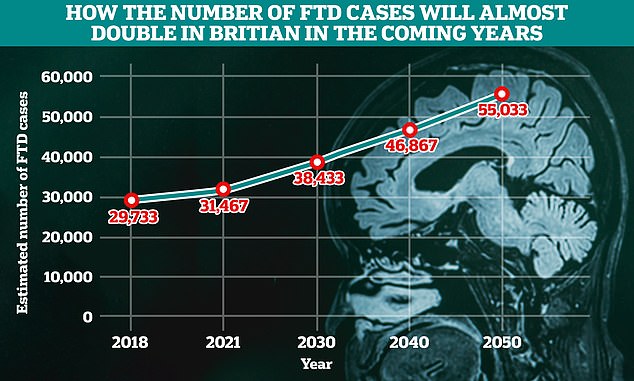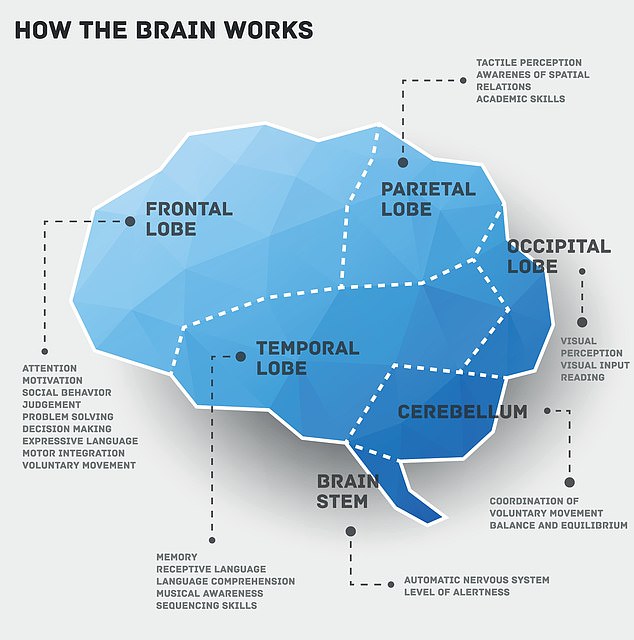Rates of an aggressive type of dementia suffered by talk show host Wendy Williams are expected to rise by almost 75 per cent in Britain in the coming years.
Causes of frontotemporal dementia (FTD) parts of the brain shrink over time.
Patients often experience changes in their mood, becoming more aggressive and having problems with their memory.
The disease can also causePhasia, which causes someone difficulty with speech and language.
Both Williams, and recently Die Hard star Bruce Willis, have suffered from aphasia as a result of their battle with FTD.

MailOnline analysis suggests the number of FTD patients in the UK could exceed 55,000 by 2050, a 75 per cent increase compared to current estimates.


Wendy Williams was diagnosed with frontotemporal dementia and aphasia, her care team revealed Thursday; seen in February 2020 in New York


The diagnosis is the same as that suffered by Die Hard star Bruce Willis, 68
Experts say that most patients with FTD need to receive full-time care only three to five years after their initial diagnosis, and the disease progresses rapidly.
Another unusual aspect of this still poorly understood subtype of dementia is how it usually affects people much younger than normal.
One in 30 dementia patients in the UK has FTD, according to Alzheimer’s Research UK.
This equates to approximately 31,000 Britons currently living with the disease, but does not include those who may be in the early undiagnosed stages.
But MailOnline analysis suggests this figure could rise to 55,000 by 2050, based on current projections for dementia patients overall.
It is estimated that by then 1.6 million Britons will be living with all forms of dementia, up from 900,000 today.
It means the number of Britons living with FTD will have increased by 75 per cent on the current total.
Most of these FTD cases will be unusually young for patients with dementia, and most patients with this condition will be between 45 and 64 years old.
Experts consider FTD to be the leading cause of “young-onset” dementia, when the disorder develops before age 65.
Experts warn that this can often lead to late diagnosis for those with FTD, and many doctors do not suspect that younger patients may have the condition.
Some mistakenly attribute classic symptoms to other potential causes such as stress or depression.
As the disease progresses, more and more areas of the brain deteriorate.
This is when symptoms become similar to late-stage Alzheimer’s, including difficulty eating or swallowing, needing help walking, and vulnerability to infections.
Like Alzheimer’s, FTD is thought to be caused by an abnormal buildup of proteins around nerve cells that eventually leads them to die.
Scientists are still trying to figure out what triggers this protein buildup in the first place, but many cases are suspected to be linked to our genes.
Up to one-third of FTD patients are thought to inherit the genes responsible for the disease directly from their parents.
Others are believed to have minor genetic quirks that slightly increase their risk of developing FTD.
Like other forms of dementia, experts believe that exercising regularly and eating a balanced diet are the best ways to help prevent the condition.
In the United States, FTD accounts for approximately one in 20 cases of dementia, which is equivalent to approximately 50,000 to 60,000 Americans.


95 percent of right-handed people and two-thirds of left-handed people use the left side of the frontal and temporal lobes of their brain to process speech. The remaining third of left-handers have right-brain predominance. When there is damage to this portion of the brain, speech and language suffer.
Dementia is a general term used to describe a variety of progressive neurological disorders (those affecting the brain), which affect memory, thinking and behaviour.
Common symptoms include memory loss, poor judgment, confusion, repeating questions, difficulty communicating, taking longer to complete normal daily tasks, acting impulsively, and mobility problems.
Alzheimer’s disease still accounts for the majority of dementia cases, responsible for about 60 percent of the total.
FTD, like other forms of dementia, is incurable and will eventually kill the patient as the condition progresses and affects more and more areas of the brain that affect bodily functions, for example swallowing.
Experts have warned that Britain, like many developed countries, faces a dementia time bomb as cases rise alongside an aging population.
In October, scientists warned that the UK “must be prepared” for the growing burden of ensuring dementia patients, regardless of their financial circumstances, receive the care they need.
Dementia is currently estimated to cost the UK £34.7 billion each year, although this is expected to rise to £94.1 billion according to the Alzheimer’s Society charity.
These costs are a combination of NHS care and treatment, social care and unpaid care provided by family members.

